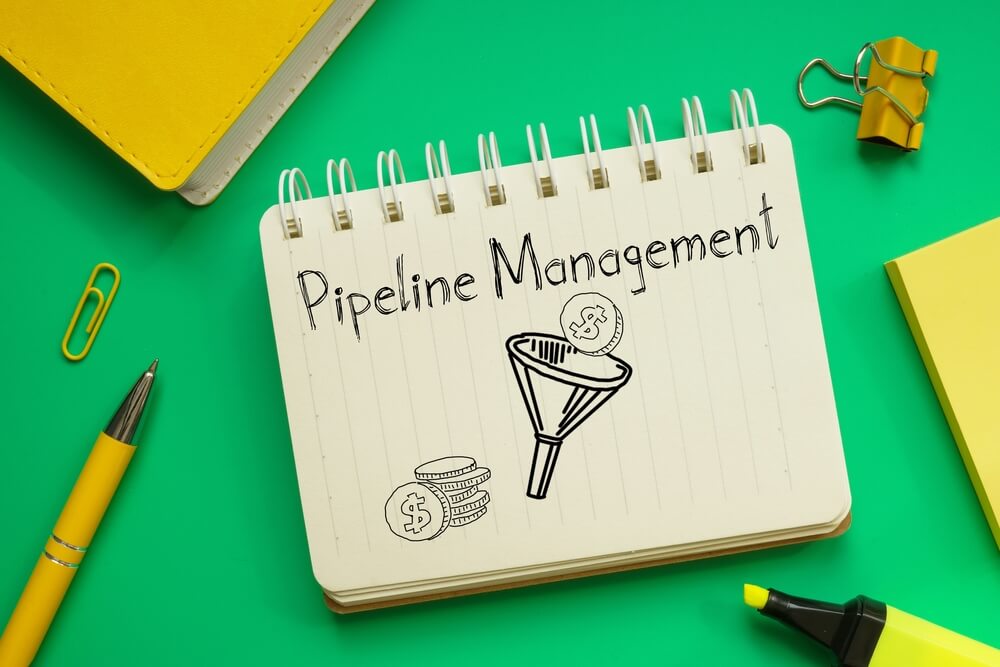
What Makes B2B Sales Pipeline Management Successful? (5 Tips)
Effective sales pipeline management leads to sustained business-to-business (B2B) success. Unlike consumer-focused sales, B2B transactions are often complex, with longer sales cycles. They require a more strategic approach to managing leads and opportunities.
This article dissects the primary factors and tips for successful B2B sales pipeline management:
- Comprehensive lead qualification.
- Regular review and adjustment.
- Use of customer relationship management (CRM) tools.
- Sales team training.
- Data-driven decision-making.
This guide also covers how fractional sales management services help B2Bs manage their sales pipeline effectively. Learn how to drive revenue growth below. Let’s go!
Need some direction for increasing sales? Watch this video to learn what DAP can do for you!
1. Promote Comprehensive Lead Qualification
Meticulously overseeing the sales pipeline enables businesses to navigate the complexities of B2B transactions. It begins with lead qualification.
Efficient lead qualification is critical in B2B sales because it offers clarity and direction in navigating complex sales cycles. Thoroughly assessing prospects identifies those with the highest potential for conversion, optimizes resource allocation, and maximizes return on investment (ROI).
Fractional sales managers build a results-driven sales pipeline because this reduces the risk of pursuing unqualified leads and conserves valuable resources while enhancing sales efficiency. Lastly, prioritizing comprehensive lead qualification empowers sales teams to focus on prospects most likely to drive meaningful revenue and long-term partnerships.
Marketing experts boost lead qualification tactics with these strategies:
- Define the characteristics of ideal customers. Include their industry, company size, budget, and pain points.
- Implement a lead scoring system to objectively evaluate leads based on engagement level, demographic information, and behavior.
- Assign numerical values to different criteria to prioritize leads and allocate resources accordingly.
- Foster collaboration between sales and marketing teams to align them with qualification criteria.
- Establish clear guidelines for lead handoff between departments to facilitate seamless transitions and reduce the risk of leads slipping through the cracks.
- Implement a set of qualification questions and criteria that sales representatives can use to assess lead fit and readiness.
Experienced sales managers also continuously monitor and review the qualification criteria for relevance and effectiveness. They solicit feedback from their teams regarding lead quality and adjust qualification parameters when needed.
2. Review and Adjust the Pipeline

One of the critical sales management processes is review. Markets and customer preferences rapidly change. Regularly assessing and adjusting the sales pipeline makes it responsive to these shifts. It also informs priorities by identifying emerging trends, capitalizing on new opportunities, and mitigating potential risks.
Here are techniques to help you evaluate and refine the sales pipeline:
- Establish regular intervals for reviewing the sales pipeline to quickly identify challenges and maximize opportunities. Do it weekly, biweekly, or monthly.
- Leverage customer relationship management (CRM) systems to centralize pipeline data and facilitate real-time updates.
- Define every sales pipeline stage clearly. Each needs to match a phase in the customer’s buying journey.
- Monitor key performance indicators (KPIs) such as conversion rates, sales cycle length, and deal size to gauge pipeline health and performance.
- Analyze both won and lost deals to identify patterns, trends, and areas for improvement.
In addition, consider working with fractional sales management services to create a culture of transparency and collaboration in the organization. Expert marketers encourage regular communication and feedback and guide members in identifying ways to optimize the pipeline.
3. Implement Effective Use of CRM Tools
Integrating CRM tools into the sales process is one of the best practices. These platforms centralize and organize critical customer data. Sales teams effectively track interactions and manage leads. They also keep track of the customer’s journey and progress in the pipeline in real time.
CRMs let you analyze historical data, identify trends, and accurately forecast sales. They streamline workflows, enhance collaboration, and drive more informed decision-making in sales.
How do you leverage CRM platforms for tracking interactions, managing follow-ups, and analyzing sales data? Consider these tips:
- Use CRM tools to record interactions with leads and customers across various channels. For example, integrate AI-powered options in B2B email marketing and social media.
- Automate follow-up tasks and nurture leads at every sales funnel stage.
- Leverage CRM segmentation capabilities to categorize leads and customers based on demographics, engagement levels, purchase history, and other relevant criteria.
- Tailor communication and follow-up strategies to address the unique needs and preferences of different segments, increasing the relevance and effectiveness of outreach efforts.
- Maximize CRM dashboards and reporting tools to track key sales performance metrics, such as conversion rates, pipeline velocity, and win-loss ratios.
- Generate accurate sales forecasts to help sales leaders determine emerging revenue streams and align resources as appropriate.
- Incorporate predictive analytics to identify potential upsell or cross-sell opportunities and prioritize leads with the highest likelihood of conversion.
- Integrate CRM into sales, marketing, and customer support platforms for cross-functional collaboration.
CRMs effectively track interactions, manage follow-ups, and analyze sales data. Using them optimizes your pipeline management processes, drives efficiency, and ultimately enhances customer relationships and revenue generation.
4. Support Focused Sales Team Training

The B2B industry involves longer sales cycles, multiple decision-makers, and nuanced negotiation strategies. Ongoing sales training equips the team with the skills, expertise, and knowledge to excel in a complex business environment.
Continuous training also helps sales professionals adapt their approach and effectively address changing customer needs by staying abreast of industry trends, market dynamics, and emerging technologies. With sales team training, you foster a culture of learning and development.
Fractional sales managers harness the team’s skills in negotiation, relationship building, and product knowledge with these ideas:
- Conduct regular role-playing sessions where team members simulate various sales scenarios. Let them practice their negotiation tactics, objection handling, and communication skills.
- Invest in third-party B2B sales training workshops or seminars.
- Encourage peer learning and mentorship within the sales team. Allow experienced representatives to share the best practices, provide feedback, and guide junior members.
- Discuss real-world case studies and examples of successful B2B sales engagements to illustrate effective negotiation strategies, relationship-building techniques, and product knowledge.
- Facilitate collaboration between sales, marketing, product development, and customer support teams to foster a holistic understanding of products, customer needs, and market dynamics.
- Implement a culture of continuous feedback and coaching. Provide regular, constructive feedback to team members on their performance, identify areas for improvement, and offer personalized coaching and development plans.
5. Embrace Data-Driven Decision-Making
A data-driven approach to pipeline management empowers you to make informed decisions based on quantitative insights rather than intuition alone. Analyzing conversion rates, pipeline velocity, and lead sources helps you identify trends, anticipate customer behavior, and optimize sales strategies.
Data-driven decision-making also supports transparency and accountability within sales teams. It lets you track progress, measure performance, and effectively allocate resources.
The following are effective ways to use sales data and analytics to make informed decisions, forecast sales trends, and refine strategies:
- Monitor essential sales metrics such as conversion rates, average deal size, and sales cycle length to identify patterns, trends, and areas for improvement.
- Use sales data to segment customers based on demographics, behavior, and purchasing patterns.
- Leverage historical sales data and predictive analytics to forecast future sales trends and anticipate demand.
- Analyze data to determine which sales channels and marketing campaigns generate the highest ROI.
- Conduct a thorough analysis of the sales pipeline to identify bottlenecks, inefficiencies, and areas for optimization.
Establish a feedback loop where sales data informs ongoing improvements and adjustments to sales strategies and processes. Encourage collaboration between sales, marketing, and product teams to share insights and iterate on methods based on data-driven feedback.
Summing Up
Adopting the best B2B sales management practices such as clear pipeline stages, robust lead qualification, and regular performance monitoring streamlines processes, prioritizes high-potential leads, and adapts strategies.
It also empowers the business to take a more strategic, data-driven approach to sustaining growth in highly competitive environments.
How can your business continuously adapt its B2B sales pipeline strategies to stay competitive in a dynamic market? Contact Digital Authority Partners (DAP) today and talk to an expert in fractional sales management services to learn more.
Want To Meet Our Expert Team?
Book a meeting directly here




